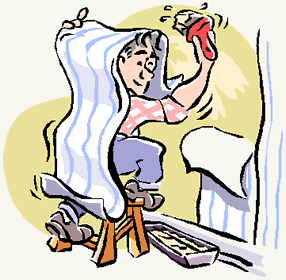
Figure 1 - Hanging wallpaper
In order to hang wallpaper you will need some basic tools:
Tape Measure Screwdriver Drop Cloth 6" Wall Scraper Sandpaper Spackling Compound Putty Knife |
Plastic Bucket Bleach Primer-Sealer Vinyl Wall Sizing Level Pencil Yard Stick or Straight Edge |
Razor Knife and Extra Blades Large Table or Smooth Surface Paste Paint Roller Water Tray Prepaste Activator |
Brush or Plastic Smoother Step Ladder Sponge Seam Roller Scissors Vinyl-over-Vinyl or Border Adhesive |
Before You Start
- Turn of electrical power and remove all switch plates and outlet covers.
- Remove old wallpaper.
- Fill in any holes or cracks with spackling compound.
- Sand the walls, removing any paste residue or excess spackle. The walls should be smooth and clean. Gloss paint must be sanded to a dull surface.
- It's a good idea to sand down the walls even if wallpapered to insure removal of any imperfections
- Wash walls with a mild detergent to remove any dirt or dust created from sanding and allow to dry thoroughly.
- For mildewed walls, wash with 2 cups of bleach mixed with 2 gallons of water. Let dry and use primer-sealer.
- Cover dry wall, newly painted, and spackled walls with primer-sealer and let dry for 24 hours.
- Completely cover walls with vinyl wall sizing to insure that the wallpaper will easily slide when positioning each sheet. Sizing also helps prevent air pockets.
- Repaint trim or ceiling if necessary.
- Before hanging, check the pattern and run or dye lot numbers on each bolt to make sure they are all the same. Completely read the manufacturer's instructions. Check each bolt for printing and shading defects.
- Save labels and packaging information in case you need to buy more wallpaper.
- Create A Plumb Line
- Start with the least noticeable wall. Measure out from the corner and mark the wall the width of the paper minus 1/2 inch. Place a level at the mark and draw a straight, vertical line (plumb line). This will be a guide for where your first two strips will meet.
- The success of your job depends on having the first strip straight. Follow this procedure every time you reach a corner or start a new wall.
- Go around the room and mark where each strip will end to keep track of the number of strips needed. This will also help avoid ending with a narrow strip that would be difficult and wasteful to hang. Catching this in advance will allow you to adjust your starting point.
- Measuring & Cutting The First Strip
- Unroll part way and hold the first roll of wallpaper against the wall to determine where you want the pattern to fall at the ceiling line.
- Mark the spot with a pencil on the back of the roll (try beginning with a full design at the ceiling). Cut the first strip with a straight edge. Leave about 2 extra inches at the top and bottom for trimming.
